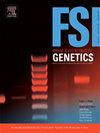统一 STR 位点 D6S474 和 DYS612 的法医术语
IF 3.2
2区 医学
Q2 GENETICS & HEREDITY
引用次数: 0
摘要
常染色体 STR D6S474 和 Y 染色体 STR DYS612 在法医文献中以多种方式进行了报道,在括号内的重复结构和基于数字长度的毛细管电泳(CE)等位基因计数方面都存在差异。当 STR 位点被引入商用检测方法,并将结果与历史上发表的等位基因频率数据进行比较,或使用参考材料对多种检测方法进行鉴定时,这些问题往往会暴露出来。我们回顾了法医文献和其他相关信息,并就今后如何处理每种 STR 提出了建议。本文章由计算机程序翻译,如有差异,请以英文原文为准。
Harmonizing the forensic nomenclature for STR loci D6S474 and DYS612
The autosomal STR D6S474 and the Y-chromosomal STR DYS612 have been reported in multiple ways in the forensic literature, with differences in both the bracketed repeat structures and counting of numerical length-based capillary electrophoresis (CE) alleles. These issues often come to light when STR loci are introduced in commercial assays and results compared with historical publications of allele frequency data, or multiple assays are characterized with reference materials. We review the forensic literature and other relevant information, and provide suggestions for the future treatment of each STR.
求助全文
通过发布文献求助,成功后即可免费获取论文全文。
去求助
来源期刊
CiteScore
7.50
自引率
32.30%
发文量
132
审稿时长
11.3 weeks
期刊介绍:
Forensic Science International: Genetics is the premier journal in the field of Forensic Genetics. This branch of Forensic Science can be defined as the application of genetics to human and non-human material (in the sense of a science with the purpose of studying inherited characteristics for the analysis of inter- and intra-specific variations in populations) for the resolution of legal conflicts.
The scope of the journal includes:
Forensic applications of human polymorphism.
Testing of paternity and other family relationships, immigration cases, typing of biological stains and tissues from criminal casework, identification of human remains by DNA testing methodologies.
Description of human polymorphisms of forensic interest, with special interest in DNA polymorphisms.
Autosomal DNA polymorphisms, mini- and microsatellites (or short tandem repeats, STRs), single nucleotide polymorphisms (SNPs), X and Y chromosome polymorphisms, mtDNA polymorphisms, and any other type of DNA variation with potential forensic applications.
Non-human DNA polymorphisms for crime scene investigation.
Population genetics of human polymorphisms of forensic interest.
Population data, especially from DNA polymorphisms of interest for the solution of forensic problems.
DNA typing methodologies and strategies.
Biostatistical methods in forensic genetics.
Evaluation of DNA evidence in forensic problems (such as paternity or immigration cases, criminal casework, identification), classical and new statistical approaches.
Standards in forensic genetics.
Recommendations of regulatory bodies concerning methods, markers, interpretation or strategies or proposals for procedural or technical standards.
Quality control.
Quality control and quality assurance strategies, proficiency testing for DNA typing methodologies.
Criminal DNA databases.
Technical, legal and statistical issues.
General ethical and legal issues related to forensic genetics.

 求助内容:
求助内容: 应助结果提醒方式:
应助结果提醒方式:


